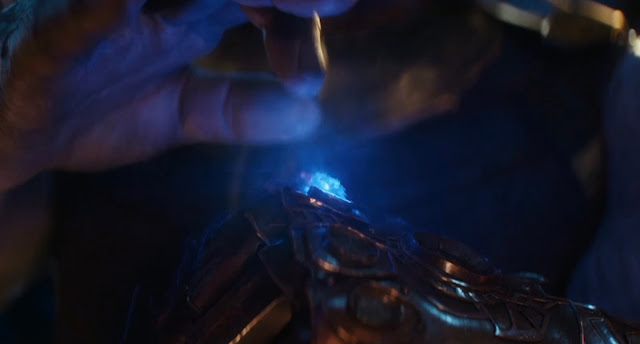I’ve spent the last 16 hours chewing over how I would write a review — with nary a spoiler — of Marvel Studio’s “Avengers: Infinity War.”
It is a tall task. From the earliest moments in the film, major characters find themselves in impossible situations.
We all know the basic story... a genocidal evil-doer named Thanos is trying to collect six multi-colored gems knows as Infinity Stones.
The Avengers — along with the Guardians of the Galaxy — are attempting to thwart those efforts and restore order to the Marvel Cinematic Universe. The story picks up where last fall’s “Thor: Ragnarok” left off (read my review of “Thor: Ragnarok”)...
Since the first “Iron Man” movie was released a decade a go, we’ve seen our heroes — either solo, or in various mix-and-match combinations — face antagonists hell bent on destruction in various forms.
In my mind, the big question going into “Avengers: Infinity War” was whether or not a battle against a purple alien (who has a gauntlet full of powerful gems that look like they were plucked from a Jostens class ring) could be any more compelling than any of the other scrapes our heroes have been in.
Marvel Studios (along with parent company Walt Disney) has been building to this movie for a decade.
In that time, the Marvel Cinematic Universe has changed the box office in such a fundamental way that you’d be hard-pressed to imagine movie-going without these films.
Let’s get down to brass tacks.
The movie delivers. It is big and bold — a hearty helping of popcorn fun.
Marvel Studios again shows its skill at weaving science fiction and fantasy in such a sensible manner that it all seems logical.
“Avengers: Infinity War” strikes the right balance between those elements. At no moment does the film ever seem like an effort to slap a bunch of superheroes together to pander to ravenous fanboys (as was the case with DC/Warner Bros.' “Justice League” last November).
Any movie that can turn Doctor Strange (Benedict Cumberbatch) into a badass, make you fear “Purple Josh Brolin,” and leave you stunned when the final credits roll is doing something right.
The movie employs its own brand of “Star Trek II: The Wrath of Khan’s” Kobayashi Maru scenario — giving our heroes an impossible task to solve.
Let’s face it, Marvel has spent a decade making the impossible possible.
When “Avengers: Infinity War” wraps up in 2019 (with a fourth “Avengers” movie), it does make you wonder where things will go moving forward.
To be sure, Disney’s cash cow won’t end in the foreseeable future.
Like many movie-goers, there are certain films I make a point of seeing. Marvel movies are perpetually on my “must-see” list (along with the “Star Wars” films).
The thing to ponder is whether Disney will ever see the “law of diminishing returns” come to fruition as it regards the Marvel Cinematic Universe...
Marvel Studios President Kevin Feige is the maestro conducting this symphony — keeping all the instruments playing in perfect unison.
Marvel movies are more like episodes in a sprawling, serialized TV series — with each season being comprised of the movies released in each calendar year.
These characters have become like old friends for fans.
Because each movie builds on the next, there is added depth and dimension to the stories.
For example, when we first see T’Challa (Chadwick Boseman) in Wakanda in “Avengers: Infinity War,” a smile came to my face. Not because anything particularly interesting was happening in that moment, but because we had learned how smart and tough he and his fellow Wakandans were in February’s “Black Panther” (read my review of “Black Panther”).
Being that I am not familiar with every nugget of source material in the Marvel stable, I don’t know if there is a villain out there more powerful than Thanos for our heroes to face at some point down the road.
While shocking things happen in the latest “Avengers” installment, I wouldn’t take things at face value. Anything is possible with a fertile imagination in this universe.
Directors Anthony and Joe Russo should be commended for helming another terrific entry in the Marvel series. Their first outing in the MCU — 2014’s “Captain America: The Winter Soldier" — is one of my favorite action movies the past decade.
At one point in “Avengers: Infinity War,” Peter Quill (Chris Pratt) is asked “What master do you serve?” and he replies, “Do you expect me to say Jesus?” (...or something to that effect).
Quite honestly, the Son of God could show up in the MCU and he’d likely blend in seamlessly.
That’s why these movies are such a pleasure to watch. In the hands of other studios, combining elements of science fiction, fantasy, and mythology with dozens of characters — over 19 films — would result in a hot mess.
In Marvel’s hands, the result is a refreshing drink worth sampling time and again...
P.S. — Be sure to stay through the end credits (if you're a Marvel fan, you know the drill...)
Also... am I the only one who notices something wrong with this image from one of the trailers promoting "Avengers: Infinity War"...?








































